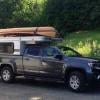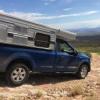Working on the same thing ...I'll send my settings.... today with a 2 hour drive batteries at 14.2....

LiFePO4Blue Brand Battery & DC-DC Chargers
#41

Posted 16 September 2020 - 12:06 AM
2016 Duramax 2.8 Diesel long bed Colorado 4WD with 2011 Eagle
#42

Posted 16 September 2020 - 12:48 AM
2012 ATC Puma Shell build - https://www.wanderth...012-puma-build/
Power considerations thread - https://www.wanderth...e-power-scotty/
Building out an electrical system - So, you want to setup a good electrical system in your camper? - Electrical, Charging, Solar, Batteries and Generators - Wander the West
#43

Posted 16 September 2020 - 03:02 AM
Just got my victron 12/12-30 installed, but camper is not on truck to run full system tests. Decided to go ahead and build a cooling solution as well.
I went with the following setup:
Blower style fan that is easy to flush mount on the wall below the V12/12-30: 
https://www.amazon.c...0?ie=UTF8&psc=1
uxcel 40c temp switch: 
https://www.amazon.c...0?ie=UTF8&psc=1
To mount the sensor I cut a strip of tin about 7 inches long, drilled a hole in the middle for sensors wires to exit then folded it into a sandwich to hold the sensor, then dog eared the top sides so that it will rest on the top of the fins. Slide it down between two fins and the sensor is somewhere in the middle of the heatsink and the wires exit below to attach to the rest of the circuit.

Edited by Alvis, 16 September 2020 - 03:33 AM.
2015 F150 Supercab 6.5 foot bed 2.7
2016 ATC Ocelot side dinette
#44

Posted 16 September 2020 - 08:04 PM
I now think that I do NOT have a smart alternator. If you google the question "How do you determine if you have a smart alternator?", it says to turn off all accessories, run the engine for 5 to 10 min, then measure voltage at the Starter Battery. If it reads about 14.4 volts you probably have a traditional alternator. If it measures at 12.5 to 13.5 volts you probably have a smart alternator. My measurement was 14.15 volts. A bit ambiguous, but I would say probably a traditional alternator.
I called the Ford service department here, and they said they had never heard of a smart alternator. All they could say was that I had a 200 Amp alternator. My truck does have "auto start and stop", where the engine shuts off in circumstances when you come to a stop, but this is not the same as a "smart alternator."
My system works now, except it periodically trips the 30 amp breaker. So I am turning it off until I can upgrade my wiring from the start battery to the DC-DC charger from the stock 10 AWG and 30 amp fuse, to 6 AWG and 50 amp fuse.
#45

Posted 16 September 2020 - 08:08 PM
No problems thus far with 2014 Ford F150, 6awg, and 60amp breakers
2021 Ford XL SuperCrew HD Payload Pkg
2008 FWC Hawk
Western Colorado, USA
Instagram: @lukeyfiasco
#46

Posted 19 September 2020 - 01:11 AM
I got my 6awg wires today and did a quick and dirty hook up (through the window) to test them out. Very interesting results.
I have a battery switch where I can choose the alternator/start battery to go to the DC-DC charger, or to bypass the DC-DC charger and hook the alternator/start battery directly to my LifeBlue house battery. First I tested the 6 awg wires using the DC-DC charger: I got about the same 25 amps of charge (measured by the LifeBlue battery bluetooth monitor) as I got with the original 10 awg stock wiring. The difference was that with the added 6 awg wires I did not experience the auto reset circuit breaker tripping every two minutes.
Then I by-passed the DC-DC charger and tested the alternator charging the LifeBlue house battery directly, through the 6 awg wires. Here I got 22 amps of charge! In both cases I left the original 10 awg wires in place.
Conclusion: Adding the 6 awg wires to the original 10 awg increases my charging from 6 or 7 amps to 22 amps. A big and useful change. Adding the DC-DC charger only adds an additional 3 amps of charge, from 22 amps to 25 amps! So, for me the DC-DC charger was a waste of money and time to install. I would have been happy to live with the direct charge from alternator to LifeBlue, controlled by a manual switch. I hope this info is useful to some others. My adivise: upgrade your wires first, and only then decide if you need the hassle and expense of adding a DC-DC charger.
#47

Posted 19 September 2020 - 03:35 AM
interesting data Zirdu. In my case, I added the DC-DC to protect my alternator. Never did test the LiPo4 batteries doing directly to the alternator over my 2g wires, but did do that when I still had AGM batteries (in my Hawk camper). I saw over 90A then, and thought that with the lower internal resistance of the LiPo4 batteries I would smoke my alternator!
2012 ATC Puma Shell build - https://www.wanderth...012-puma-build/
Power considerations thread - https://www.wanderth...e-power-scotty/
Building out an electrical system - So, you want to setup a good electrical system in your camper? - Electrical, Charging, Solar, Batteries and Generators - Wander the West
#48

Posted 22 September 2020 - 12:09 AM
It looks like using the Victron DC-DC Charger with the Iota (built in charge profile) isn't so simple. It looked like it worked, but because the LiFePO4 was above 13.5 V, the DC-DC went into "absorption" mode, which for a LiFePO4 means don't charge. What I have otherwise observed was the DC-DC going into bulk charge for a moment, then the source voltage dropped to 9.7 V and then the DC-DC quit charging. The voltage comes back and then the cycle repeats.
What I think happens is that when 36A is demanded from the 30A Iota, the Iota can't handle it and the voltage drops to 9.7V. I hadn't thought it through. 30A Iota should handle a 30A DC-DC, right? No, it's 30A out of the DC-DC but up to 36A in. I'll try a current limiting resister in-line to see if that works.
Edited by Jack, 22 September 2020 - 12:12 AM.
2015 Fleet on 2019 Ranger
#49

Posted 29 September 2020 - 11:58 PM
Hey all... Victron just updated the firmware for the Orion. It now has settings for "smart" vs "normal - aka dumb?" alternators and all the default settings now work like a charm. MUCH better!
2012 ATC Puma Shell build - https://www.wanderth...012-puma-build/
Power considerations thread - https://www.wanderth...e-power-scotty/
Building out an electrical system - So, you want to setup a good electrical system in your camper? - Electrical, Charging, Solar, Batteries and Generators - Wander the West
#50

Posted 30 September 2020 - 12:29 AM
Thanks Vic, I went outside to stand beside camper as the Bluetooth is sort of weak.... pouring rain! Gave up and will do update tomorrow. I put in my own idea for setting and nothing blew up and batteries are great.I would prefer their settings though as I.’m usually on a wing and a prayer.
2016 Duramax 2.8 Diesel long bed Colorado 4WD with 2011 Eagle
0 user(s) are reading this topic
0 members, 0 guests, 0 anonymous users
















